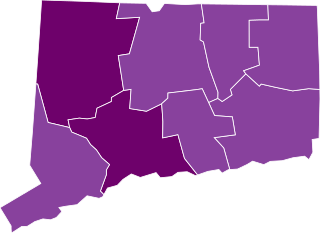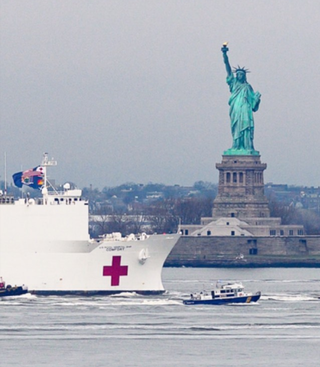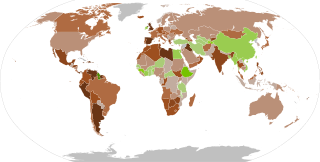
Sam Abbas is an Egyptian film director, screenwriter, and producer. He is noted for his artfully composed, poetic, and incident-like tableaus film style.

The COVID-19 pandemic had a negative effect on certain films in the early 2020s, mirroring its impacts across all arts sectors. Across the world, and to varying degrees, cinemas and movie theaters were closed, festivals were cancelled or postponed, and film releases were moved to future dates or delayed indefinitely. Due to cinemas and movie theaters closing, the global box office dropped by billions of dollars, streaming saw a significant increase in popularity, and the stock of film exhibitors dropped dramatically. Many blockbusters originally scheduled to be released by mid-March 2020 were postponed or canceled around the world, with film productions also being halted. This in turn created openings for independent cinema productions to receive wider exposure.

The COVID-19 pandemic was confirmed to have reached the U.S. state of Maryland in March 2020. The first three cases of the virus were reported in Montgomery County on March 5, 2020. As of December 16, 2022, the Maryland Department of Health (MDH) reported 1,303,829 positive cases, 15,575 confirmed deaths, and 4,914,005 are fully vaccinated with the primary vaccination series. County fully vaccinated rates range from 93% in Montgomery County to 52% in Somerset County.

The COVID-19 pandemic in Texas is a part of the ongoing viral pandemic of coronavirus disease 2019 (COVID-19), a novel infectious disease caused by severe acute respiratory syndrome coronavirus 2 (SARS-CoV-2). The state of Texas confirmed its first case on February 13, 2020, among U.S. nationals evacuated from China to Joint Base San Antonio–Lackland beginning in early February; however, retrospective analyses have suggested a much earlier origin than previously thought. The first documented case of COVID-19 in Texas outside of evacuees at Lackland was confirmed on March 4 in Fort Bend County, and many of the state's largest cities recorded their first cases throughout March. The state recorded its first death associated with the disease on March 17 in Matagorda County.

The first confirmed case of the COVID-19 pandemic in the U.S. state of Connecticut was confirmed on March 8, although there had previously been multiple people suspected of having COVID-19, all of which eventually tested negative. As of January 19, 2022, there were 599,028 confirmed cases, 68,202 suspected cases, and 9,683 COVID-associated deaths in the state.

The COVID-19 pandemic was confirmed to have reached the U.S. state of South Carolina in March 2020. On April 2, 2020, DHEC announced that the virus had spread to all 46 counties in the state. During the month of June the seven-day moving average of new COVID-19 cases in South Carolina increased nearly five-fold, from 293 on June 1 to 1,398 on June 30, and continued to increase during July and into August. As of August 2022 the South Carolina Department of Health and Environmental Control (DHEC) has confirmed 1,605,165 cases in the state and 18,192 deaths.

The COVID-19 pandemic had a sudden and substantial impact on the arts and cultural heritage sector. The global health crisis and the uncertainty resulting from it profoundly affected organisations' operations as well as individuals—both employed and independent—across the sector. Arts and culture sector organisations attempted to uphold their mission to provide access to cultural heritage to the community; maintain the safety of their employees, collections, and the public; while reacting to the unexpected change in their business model with an unknown end.

The U.S. state of West Virginia reported its first confirmed case relating to the COVID-19 pandemic on March 17, 2020, becoming the last state to do so. The patient had shown symptoms for several days prior. On March 29, 2020, the state reported its first COVID-19 death.

The first case of the COVID-19 pandemic in New York City was confirmed on March 1, 2020, though later research showed that the novel coronavirus had been circulating in New York City since January, with cases of community transmission confirmed as early as February. By March 29, over 30,000 cases were confirmed, and New York City had become the worst-affected area in the United States. There were over 2,000 deaths by April 6; at that stage, the city had more confirmed coronavirus cases than China, the UK, or Iran. Bodies of the deceased were picked up from their homes by the US Army, National Guard, and Air National Guard.

The COVID-19 pandemic affects the global food industry as governments close down restaurants and bars to slow the spread of the virus. Across the world, restaurants' daily traffic dropped precipitously compared to the same period in 2019. Closures of restaurants caused a ripple effect among related industries such as food production, liquor, wine, and beer production, food and beverage shipping, fishing, and farming.

The COVID-19 pandemic is an ongoing viral pandemic of coronavirus disease 2019 (COVID-19), a novel infectious disease caused by severe acute respiratory syndrome coronavirus 2 (SARS-CoV-2). The pandemic affected the city of Columbus, Ohio, as Ohio's stay-at-home order shuttered all nonessential businesses, and caused event cancellations into 2021. The shutdown led to protests at the Ohio Statehouse, the state capitol building.
The COVID-19 pandemic in Boston is part of an ongoing viral pandemic of coronavirus disease 2019 (COVID-19) in the Massachusetts city of Boston. The first confirmed case was reported on February 1, 2020, and the number of cases began to increase rapidly by March 8. Massachusetts Governor Charlie Baker declared a state of emergency on March 10. Mayor Marty Walsh declared a public health emergency on March 15. By March 21, more than a hundred people in Boston had tested positive for COVID-19. Most early cases were traceable to a company meeting held in late February by the biotechnology firm Biogen in Boston.

The COVID-19 pandemic has had a significant impact on the performing arts, mirroring its impacts across all arts sectors. Due to physical distancing requirements and closure of the physical venues, curtailing not only public performances but also rehearsals, many performing arts institutions attempted to adapt by offering new digital services. In particular this resulted in the free online streaming of previously recorded performances of many companies – especially orchestral performances and plays – lists of which were collated by journalists as well as bespoke crowdsourcing projects.

The Walt Disney Company and its subsidiaries have been variously impacted by the COVID-19 pandemic; the company has business interests in areas that involve mass gatherings and isolation.

This article documents the chronology of the response to the COVID-19 pandemic in June 2020, which originated in Wuhan, China in December 2019. Some developments may become known or fully understood only in retrospect. Reporting on this pandemic began in December 2019.

The COVID-19 pandemic affected the 2020 Hajj (pilgrimage), which is the fifth pillar of the Five Pillars of Islam, where millions of Muslims from around the world visit Mecca and Medina every year during Hajj season for a week. Over 2,400,000 pilgrims attended Hajj in 2019. Due to the highly contagious nature of COVID-19 in crowded places, various international travel restrictions, and social distancing recommendations, the Ministry of Hajj and Umrah advised Muslims to postpone their pilgrimage until the pandemic was mitigated. However, in June 2020, the Ministry opened up Hajj to people of all nationalities residing in Saudi Arabia, with foreigners still banned from attending to ensure pilgrims' safety and prevent the transmission of COVID-19.
This article documents the chronology of the response to the COVID-19 pandemic in July 2020, which originated in Wuhan, China in December 2019. Some developments may become known or fully understood only in retrospect. Reporting on this pandemic began in December 2019.

The COVID-19 pandemic had a deep impact on the Canadian economy, leading it into a recession. The government's social distancing rules had the effect of limiting economic activity in the country. Companies started mass layoffs of workers, and Canada's unemployment rate was 13.5 percent in May 2020, the highest it has been since 1976.
The following is a timeline of the COVID-19 pandemic in Nevada.













